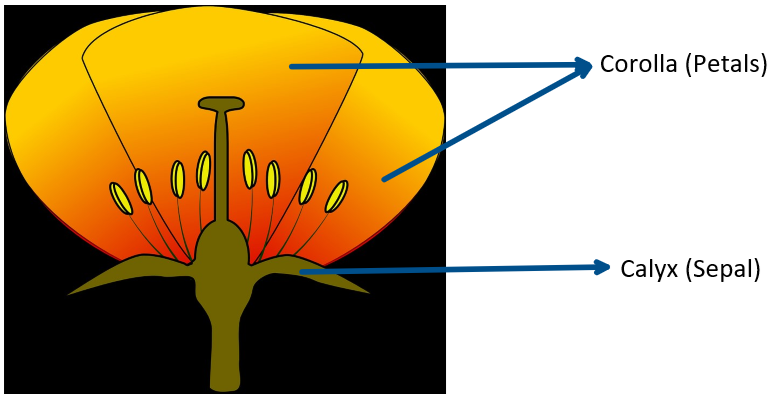
The function of the corolla in flower is:
(a).To produce male gametes
(b).To produce female gametes
(c).To hold pollen grains
(d).To attract insects
Answer
468k+ views
Hint: Corolla is an accessory whorl in flowers and consists of petals that are usually brightly colored. It helps in achieving the pollination of the flowers.
Complete answer:
Corolla in flowers plays a major role in the attraction of pollinators, 80% of which is done by insects. These pollinators are attracted to the brightly colored petals of flowers and hence help in pollination.
Additional Information:
Aestivation is the arrangement of these accessory whorls, which can include calyx and corolla in relation to each other in the floral bud. The following types of aestivation are mainly observed:
Twisted or Contorted aestivation: The adjacent margins of petals overlap each other. This type of aestivation is seen in china rose, cotton, and lady’s finger.
Imbricate aestivation: Overlapping of the margin of petals is seen but not in any specific direction. This type of aestivation is seen in cassia and Gulmohar.
Vexillary or Papilionaceous aestivation: In this type of aestivation, a large posterior petal known as standard overlaps two lateral petals known as wings, and the two lateral petals overlap two anterior petals known as the keel. This type of aestivation is seen in peas and beans.
Quincuncial aestivation: Five petals are present out of which two petals are externally situated, two petals are internal, and one petal has one margin placed externally and the other margin placed internally. This type of aestivation is seen in datura.
Valvate aestivation: No overlapping is observed between margins of adjacent petals. This type of aestivation is seen in mustard and calotropis.
So, the correct answer is ‘to attract insects.’
Note:
The perianth is a special condition where no distinction can be made between the calyx and corolla. The calyx and corolla are actually in a fused state, and each unit of this perianth is called tepal. This is observed in lily. When the perianth is greenish and gives the sepal-like appearance, it is known as sepaloid, and when the perianth resembles the petals, it is known as petaloid.

Complete answer:
Corolla in flowers plays a major role in the attraction of pollinators, 80% of which is done by insects. These pollinators are attracted to the brightly colored petals of flowers and hence help in pollination.
Additional Information:
Aestivation is the arrangement of these accessory whorls, which can include calyx and corolla in relation to each other in the floral bud. The following types of aestivation are mainly observed:
Twisted or Contorted aestivation: The adjacent margins of petals overlap each other. This type of aestivation is seen in china rose, cotton, and lady’s finger.
Imbricate aestivation: Overlapping of the margin of petals is seen but not in any specific direction. This type of aestivation is seen in cassia and Gulmohar.
Vexillary or Papilionaceous aestivation: In this type of aestivation, a large posterior petal known as standard overlaps two lateral petals known as wings, and the two lateral petals overlap two anterior petals known as the keel. This type of aestivation is seen in peas and beans.
Quincuncial aestivation: Five petals are present out of which two petals are externally situated, two petals are internal, and one petal has one margin placed externally and the other margin placed internally. This type of aestivation is seen in datura.
Valvate aestivation: No overlapping is observed between margins of adjacent petals. This type of aestivation is seen in mustard and calotropis.
So, the correct answer is ‘to attract insects.’
Note:
The perianth is a special condition where no distinction can be made between the calyx and corolla. The calyx and corolla are actually in a fused state, and each unit of this perianth is called tepal. This is observed in lily. When the perianth is greenish and gives the sepal-like appearance, it is known as sepaloid, and when the perianth resembles the petals, it is known as petaloid.

Recently Updated Pages
Master Class 12 Economics: Engaging Questions & Answers for Success

Master Class 12 Maths: Engaging Questions & Answers for Success

Master Class 12 Biology: Engaging Questions & Answers for Success

Master Class 12 Physics: Engaging Questions & Answers for Success

Master Class 12 Business Studies: Engaging Questions & Answers for Success

Master Class 12 English: Engaging Questions & Answers for Success

Trending doubts
Give simple chemical tests to distinguish between the class 12 chemistry CBSE

Define peptide linkage class 12 chemistry CBSE

Draw a labelled sketch of the human eye class 12 physics CBSE

Differentiate between lanthanoids and actinoids class 12 chemistry CBSE

Phenol on treatment with conc HNO3 gives A Picric acid class 12 chemistry CBSE

Differentiate between homogeneous and heterogeneous class 12 chemistry CBSE




